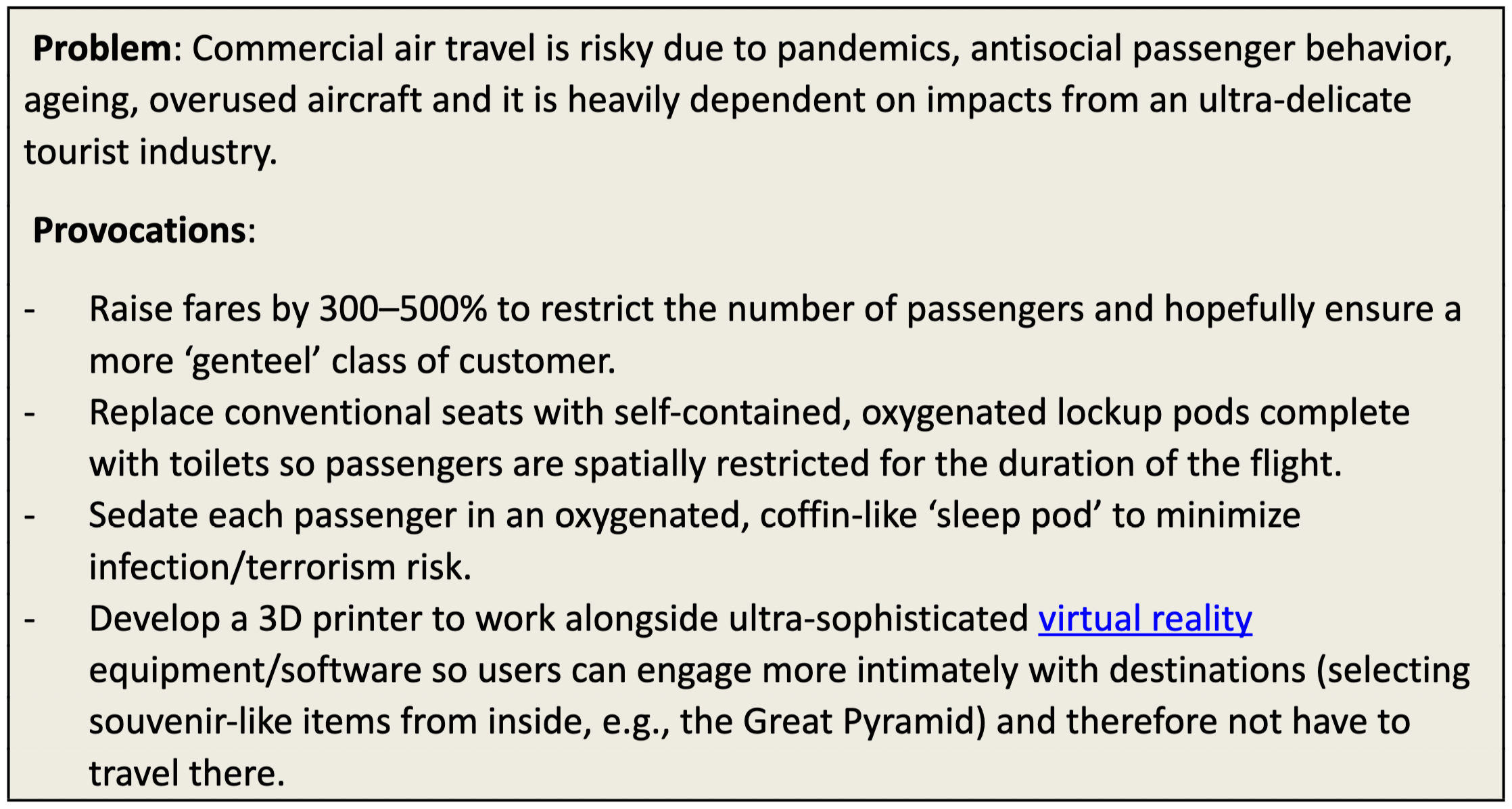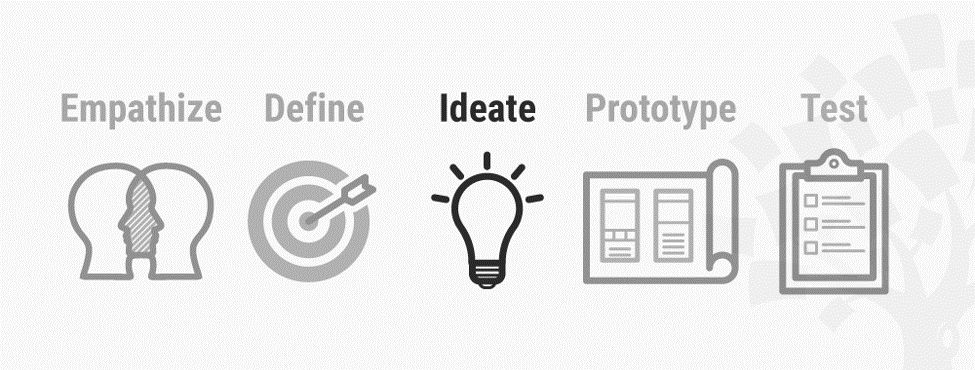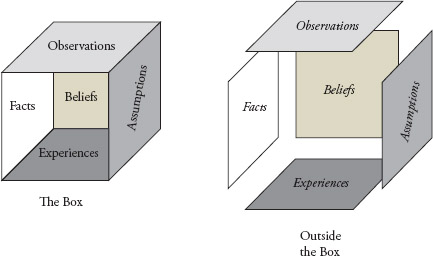

Out-of-the-Box Thinking with PRISM©
Course Duration: 2 Days (9am to 5pm) Trainer: Ted Chan
- Ended Ended
- Virtual (Zoom)
Service Description
Introduction In this interactive and highly practical 2-day workshop, participants will learn to develop the innovative mindset and skillset that are essential in innovation and creativity. Participants will learn how to think “out of the box”, discover new ideas, make decisions and solve problems effectively. Key Objectives: - Recognise the importance innovation, creative thinking and problem solving - Cultivate the Innovative Thinking Mindset that would help create a positive attitude for exploration and a greater sensitivity to opportunities - Leverage both individual and group innovative capabilities Programme Outlines 1. Introduction to Creativity and Innovation - What is Creativity and Innovation? - The Importance of Creativity and Innovation? - Myths about Creativity and Innovation? - Acquring Creative Problem Solving Skills Activities: Introducing myself: ‘My Creative Story’, ‘Let’s invent something!’ 2. The Innovative Mindset: 3As - Assault Assumptions Activity: ‘What if this is not true?’ 3. The Innovative Mindset: 3As (Continue) - Adopt Positivity - Activate Opportunity Thinking - Think ‘there is a better way’ - Pay attention to Happy Accidents - Look for customers’ problems that are not solved Activities: ‘Matching Successful People’, ‘Identifying Customers’ Bugs’ The Innovative Skillset using P.R.I.S.M.©: 4. - Problem Illumination - Contexting - Root-Cause Analysis - Problem Definition Results Definition - Guided Visioning Activities: ‘Contexting’, ‘Root-Causes Analysis using fish bone analysis/Why-Why Diagramme’, ‘Guided Visioning’ 5. Results Definition - Synesthesia - Scenario Development Activities: Video on Gratitude, ‘Scenario Development’, ‘The Perfect House/Vacation’’ 6. Ideas Generation - 7 Levels of Thinking - Brainstorming, Nominal Group Technique, Affinity Diagramming Activities: ‘Brainstorming & Brainwriting’, Video on Kangnam Style, ‘Spotting Innovative Tactics’ 7. Ideas Generation - Innovative Connections/Idea Hooks - 3Bs Activities: ‘‘Innovative Connections‘, ‘NUF Technique’, ‘Identify criteria for Weighted Decision Matrix’. 8. Selection of Solutions and Implementation - NUF Technique - Weighted Decision Matrix - Getting Buy-In Monitoring and Optimisation of Performance - Post Implementation Considerations Activities: ‘NUF Technique’, ‘Choosing Criteria’, ‘Arms folding’ Methodologies Group Discussion,Role Play,Case Studies
Contact Details
+65 93857280
To register, please contact: Bidadari Park Drive, Singapore
- Reviews / Why join our community?
- For companies
- Frequently asked questions
Outside the Box Thinking
What is outside the box thinking.
Outside-the-box thinking is an ideation form where designers freely discard common problem-solving methods to find the true nature of users’ problems, falsify old assumptions and be innovative. Vital to the design thinking process, out-of-the-box thinking means reframing problems with a wider grasp of the design space.
“Thinking outside of the box allows you to get rewards outside of your reach.” — Matshona Dhliwayo, Philosopher, entrepreneur & author
See where—and what—thinking outside the box can get you:
- Transcript loading…
Break Out of the Box to Find Spectacular Solutions
Traditional approaches to problem-solving can distort design teams’ views of problems. The most innovative solutions—both in product design and service design —usually come from designers who dared to step off the path of linear thinking to ask “Why?”. Design problems are usually complex, with many hard-to-see factors at play between users, the diverse realities they face and solutions they would find most effective, helpful and desirable. To follow a vertical, linear train of thought when addressing these would likely soon cause some big obstacles. With outside-the-box thinking, you can challenge assumptions that would otherwise constrain you, therefore freeing you to sidestep the dangers of meeting a design problem head-on.
Thinking outside the box can save you and your team the headaches of pursuing a perceived problem and ending up developing uninventive, semi-effectual solutions. So, instead of chasing shadows, you can work your way around the boundaries and explore the bigger picture. Moreover, it's a great way to discover other resources that might be available to you, spot market gaps and, indeed, inspire your design team in the ideation stage of any project . That’s why thinking out of the box is synonymous with, and integral to design thinking.
“The box” is the apparent constraints of the design space and our restrictions in perspective from habitually meeting problems as everyday “if x, then do y to get z” tasks. That clinical, critical line of reasoning we’re used to outside the design space will easily impose its limitations in design ideation. You can’t get a holistic view of the problem unless you start to explore horizontally and find its edges. To get outside the box, it’s important to:
Focus on overlooked aspects of a situation/problem .
Challenge assumptions – about any aspect of the problem or users.
Seek alternatives – not just alternative potential solutions, but alternative ways of thinking about problems .

© Yu Siang and Interaction Design Foundation, CC BY-SA 3.0
How to Break Out of Your Design Box
Lateral thinking and divergent thinking methods can lead to the best results. Early in the ideation stage is the time to get disruptive and reconnect with a similar sense of wonder to how children challenge the norms which adults grow to accept without question. A persistence with “Why?” is the key, as is a judgement-free atmosphere in your ideation session. You want to ask significant questions that may seem outlandish – the idea being to scrutinize the assumptions everyone else would go along with because they’re “the done thing” and see if they’re actually valid.
Essentially, you want to reframe the problem and:
Understand what’s constraining you and why.
Find new strategies to solutions and places/angles to start exploring.
Find the apparent edges of your design space and push beyond them – to reveal the bigger picture.
Of the various methods you can use, a chief one is provocations , where you make deliberately false statements about an aspect of the problem/situation . This could be to question the norms through contradiction, distortion, reversal (i.e., of assumptions), wishful thinking or escapism , for example:

Here, we see some norms of conventional air travel challenged and some unpredictable (and even socially unacceptable) notions to trigger our thinking. Our example showcases this method:
Bad Ideas – You think up as many bad or crazy ideas as possible, but these might have potentially good aspects (e.g., having self-contained compartments with toilets for passengers traveling together). You also establish why bad aspects are bad (e.g., raising prices so exorbitantly would A) foster social exclusion and B) not guarantee safety, anyway).
Design thinking is ideal for outside-the-box thinking, especially since its fluidity as a process lets you iteratively research, ideate, prototype and more as you fine-tune your way to the best solution. Ultimately, you should be able to investigate your problem—including factors affecting it—and harvest insights from its many dimensions by brainstorming or other means. From there, you use convergent thinking to zero in on the best solutions.

Learn More about Outside-the-Box Thinking
Take our Creativity course , featuring outside-the-box thinking.
Read how one design team leveraged outside-the-box thinking to great effect.
Grammarly’s blog succinctly captures the idea .
Questions related to Outside the Box Thinking
This video aptly answers the question of how to think outside the box.
Thinking outside the box means thinking freely and creatively—off the beaten path. It encourages a departure from standard or predictable thinking. It implies adopting unconventional and innovative approaches to problem-solving. Here is what you can do to get started:
Dive into the corners others might miss. Look beyond the obvious and focus on elements often overlooked in a situation.
Question the assumptions entrenched in the problem or regarding the users. Challenge the "given" and ask whether those assumptions are valid.
Don't settle for the expected. Seek not only solutions but also how to frame and approach the problem.
Yes, thinking outside the box is a valuable skill in problem-solving. It goes beyond regular solutions by exploring overlooked aspects, challenging norms, and looking past apparent boundaries. The skill involves questioning the usual ways of doing things and finding innovative solutions. The essence lies in addressing the edges and pushing beyond them to develop a dynamic and creative mindset.
Thinking outside the box involves lateral and divergent thinking methods.
During the ideation stage, be disruptive, persistently ask "Why?" and create a judgment-free atmosphere.
Reframe the problem by understanding constraints, finding new strategies, exploring different angles, and pushing beyond apparent boundaries to reveal the bigger picture.
Use provocations, such as deliberately false statements, to question norms and challenge assumptions.
Here are a few innovative ideas from the home to the workplace:
At Home - Imagine you have a small, unused space under your staircase at home. Comfortable seating, soft lighting, and bookshelves can turn an overlooked area into an inviting space. It demonstrates a creative use of space beyond its "supposed" purpose.
At Work - A common challenge in an eCommerce app is a high rate of product returns. It mainly happens because customers need more certainty about how items will look on them. So, you incorporate augmented reality (AR) for virtual product try-ons to enhance user satisfaction.
Creativity in thinking outside the box means introducing fresh and different ideas and breaking away from the norm. It is like analyzing other paths. The process involves exploring alternative options, questioning the "done thing," and finding clever solutions to problems. This video on Edward de Bono's "thinking hats" framework shows the connection between creative thinking and outside-the-box thinking. The "thinking hats" framework disrupts routine thinking, sparks creativity, and helps find new ideas and answers that change how to tackle challenges.
An open and dynamic perspective provides a continuous flow of imaginative thinking. Creativity and outside-the-box thinking are about going beyond regular thinking to find possibilities. It paves the way for smart solutions and makes problem-solving more interesting.
Thinking outside the box is closely tied to critical thinking. While critical thinking is a part of the process, thinking outside the box goes a step further.
Critical thinking involves analyzing, evaluating, and reasoning through information to make judgments. It encourages exploring alternative perspectives and solutions.
Thinking outside the box focuses more on creative problem-solving and challenging assumptions. It involves questioning assumptions, challenging traditional norms, and reframing problems with a broader understanding.
Thinking outside the box shares similarities with critical thinking but is not synonymous. So, while complementing each other, they represent distinct aspects of cognitive processes .
Thinking outside the box is a positive and valuable approach. It is about looking at things differently, not just sticking to the usual ideas. Such techniques make problem-solving more exciting and compelling.
While the initial introduction of unconventional ideas might seem impractical or risky, the long-term benefits are substantial. This approach has the potential to handle creative blocks , lead to breakthroughs, and overcome limitations imposed by traditional thinking.
You can sign up for our comprehensive course ' Creativity: Methods to Design Better Products and Services , to learn more about outside-the-box thinking. It equips you with skills and step-by-step methods to enhance your ability to generate innovative and valuable solutions. You will gain practical insights and tools to foster creativity in various workflows, programming algorithms, and professional settings.
Learn about hands-on ideation methods.
Explore more about divergent and convergent thinking in this video:
Literature on Outside the Box Thinking
Here’s the entire UX literature on Outside the Box Thinking by the Interaction Design Foundation, collated in one place:
Learn more about Outside the Box Thinking
Take a deep dive into Outside the Box Thinking with our course Creativity: Methods to Design Better Products and Services .
The overall goal of this course is to help you design better products, services and experiences by helping you and your team develop innovative and useful solutions. You’ll learn a human-focused, creative design process.
We’re going to show you what creativity is as well as a wealth of ideation methods ―both for generating new ideas and for developing your ideas further. You’ll learn skills and step-by-step methods you can use throughout the entire creative process. We’ll supply you with lots of templates and guides so by the end of the course you’ll have lots of hands-on methods you can use for your and your team’s ideation sessions. You’re also going to learn how to plan and time-manage a creative process effectively.
Most of us need to be creative in our work regardless of if we design user interfaces, write content for a website, work out appropriate workflows for an organization or program new algorithms for system backend. However, we all get those times when the creative step, which we so desperately need, simply does not come. That can seem scary—but trust us when we say that anyone can learn how to be creative on demand . This course will teach you ways to break the impasse of the empty page. We'll teach you methods which will help you find novel and useful solutions to a particular problem, be it in interaction design, graphics, code or something completely different. It’s not a magic creativity machine, but when you learn to put yourself in this creative mental state, new and exciting things will happen.
In the “Build Your Portfolio: Ideation Project” , you’ll find a series of practical exercises which together form a complete ideation project so you can get your hands dirty right away. If you want to complete these optional exercises, you will get hands-on experience with the methods you learn and in the process you’ll create a case study for your portfolio which you can show your future employer or freelance customers.
Your instructor is Alan Dix . He’s a creativity expert, professor and co-author of the most popular and impactful textbook in the field of Human-Computer Interaction. Alan has worked with creativity for the last 30+ years, and he’ll teach you his favorite techniques as well as show you how to make room for creativity in your everyday work and life.
You earn a verifiable and industry-trusted Course Certificate once you’ve completed the course. You can highlight it on your resume , your LinkedIn profile or your website .
All open-source articles on Outside the Box Thinking
What is design thinking and why is it so popular.

- 1.6k shares
Open Access—Link to us!
We believe in Open Access and the democratization of knowledge . Unfortunately, world-class educational materials such as this page are normally hidden behind paywalls or in expensive textbooks.
If you want this to change , cite this page , link to us, or join us to help us democratize design knowledge !
Privacy Settings
Our digital services use necessary tracking technologies, including third-party cookies, for security, functionality, and to uphold user rights. Optional cookies offer enhanced features, and analytics.
Experience the full potential of our site that remembers your preferences and supports secure sign-in.
Governs the storage of data necessary for maintaining website security, user authentication, and fraud prevention mechanisms.
Enhanced Functionality
Saves your settings and preferences, like your location, for a more personalized experience.
Referral Program
We use cookies to enable our referral program, giving you and your friends discounts.
Error Reporting
We share user ID with Bugsnag and NewRelic to help us track errors and fix issues.
Optimize your experience by allowing us to monitor site usage. You’ll enjoy a smoother, more personalized journey without compromising your privacy.
Analytics Storage
Collects anonymous data on how you navigate and interact, helping us make informed improvements.
Differentiates real visitors from automated bots, ensuring accurate usage data and improving your website experience.
Lets us tailor your digital ads to match your interests, making them more relevant and useful to you.
Advertising Storage
Stores information for better-targeted advertising, enhancing your online ad experience.
Personalization Storage
Permits storing data to personalize content and ads across Google services based on user behavior, enhancing overall user experience.
Advertising Personalization
Allows for content and ad personalization across Google services based on user behavior. This consent enhances user experiences.
Enables personalizing ads based on user data and interactions, allowing for more relevant advertising experiences across Google services.
Receive more relevant advertisements by sharing your interests and behavior with our trusted advertising partners.
Enables better ad targeting and measurement on Meta platforms, making ads you see more relevant.
Allows for improved ad effectiveness and measurement through Meta’s Conversions API, ensuring privacy-compliant data sharing.
LinkedIn Insights
Tracks conversions, retargeting, and web analytics for LinkedIn ad campaigns, enhancing ad relevance and performance.
LinkedIn CAPI
Enhances LinkedIn advertising through server-side event tracking, offering more accurate measurement and personalization.
Google Ads Tag
Tracks ad performance and user engagement, helping deliver ads that are most useful to you.
Share Knowledge, Get Respect!
or copy link
Cite according to academic standards
Simply copy and paste the text below into your bibliographic reference list, onto your blog, or anywhere else. You can also just hyperlink to this page.
New to UX Design? We’re Giving You a Free ebook!

Download our free ebook The Basics of User Experience Design to learn about core concepts of UX design.
In 9 chapters, we’ll cover: conducting user interviews, design thinking, interaction design, mobile UX design, usability, UX research, and many more!

How it works
Transform your enterprise with the scalable mindsets, skills, & behavior change that drive performance.
Explore how BetterUp connects to your core business systems.
We pair AI with the latest in human-centered coaching to drive powerful, lasting learning and behavior change.
Build leaders that accelerate team performance and engagement.
Unlock performance potential at scale with AI-powered curated growth journeys.
Build resilience, well-being and agility to drive performance across your entire enterprise.
Transform your business, starting with your sales leaders.
Unlock business impact from the top with executive coaching.
Foster a culture of inclusion and belonging.
Accelerate the performance and potential of your agencies and employees.
See how innovative organizations use BetterUp to build a thriving workforce.
Discover how BetterUp measurably impacts key business outcomes for organizations like yours.
A demo is the first step to transforming your business. Meet with us to develop a plan for attaining your goals.

- What is coaching?
Learn how 1:1 coaching works, who its for, and if it's right for you.
Accelerate your personal and professional growth with the expert guidance of a BetterUp Coach.
Types of Coaching
Navigate career transitions, accelerate your professional growth, and achieve your career goals with expert coaching.
Enhance your communication skills for better personal and professional relationships, with tailored coaching that focuses on your needs.
Find balance, resilience, and well-being in all areas of your life with holistic coaching designed to empower you.
Discover your perfect match : Take our 5-minute assessment and let us pair you with one of our top Coaches tailored just for you.

Research, expert insights, and resources to develop courageous leaders within your organization.
Best practices, research, and tools to fuel individual and business growth.
View on-demand BetterUp events and learn about upcoming live discussions.
The latest insights and ideas for building a high-performing workplace.
- BetterUp Briefing
The online magazine that helps you understand tomorrow's workforce trends, today.
Innovative research featured in peer-reviewed journals, press, and more.
Founded in 2022 to deepen the understanding of the intersection of well-being, purpose, and performance
We're on a mission to help everyone live with clarity, purpose, and passion.
Join us and create impactful change.
Read the buzz about BetterUp.
Meet the leadership that's passionate about empowering your workforce.
For Business
For Individuals
Thinking outside the box: 8 ways to become a creative problem solver

Jump to section
What does thinking outside the box mean?
3 simple examples of thinking outside the box, why thinking outside the box is important, 8 ways to think outside the box.
What if for every plateau we reach, resource limit we hit — or even every challenge we face — we stopped and asked: “what if?” What if we challenged the rules and started thinking outside the box?
That’s exactly what 17 smart software developers did in Oregon in the spring of 2000. Martin Fowler, Jim Highsmith, and 15 other colleagues convened and broke the rules of software development . They thought up a concept that completely erased the standing software development rules to speed up software time to market. That concept is the agile methodology we know today.
But what does it mean to think outside the box — to encourage workplace autonomy and innovation? After all, isn’t there value in leaving things as they are? Even when you’re not trying to disrupt an entire industry, thinking out of the box can make a difference throughout your entire organization. Read on to learn what that looks like, why it’s important, and how to think outside the box yourself.
Thinking outside the box is a metaphor often used to describe different, unconventional, novel, or creative thinking.
It shows up in simple things like using paper to make crafts — instead of just writing on them — for example. Or in more complex forms e.g thinking up concepts like agile methodology for problem-solving.
According to Fast Company, the term came into use in the 1970s . Management consultants would give clients a nine-dot puzzle and ask them to connect the dots with only four lines.

Naturally, this task requires some lateral thinking, so the consultants would encourage their clients to “think outside the box.” In this case, in order to come up with an innovative solution, they needed to literally look beyond the box and create something else.
One thing stands out for us from this exercise. At first, you see a box. To draw those four lines, you have to first exhaust the options within the box. Only then can you realize that the problem is the box itself. You come to that realization after understanding the box and uncovering its limitations.
To think outside of the box is to fully understand the status quo — then challenge it.
From the home to the workplace, and innovative ideas that drive human evolution, here’s what thinking outside the box looks like:
- At home - a better way to fold clothes : Marie Kondo thought up a way to fold clothes to save storage space and to see every piece of clothing at a glance.
- At work - doubled app downloads on a $35 Budget : In a viral marketing stunt, Thursday intern, Anya Jackson cuffed herself to a pole to generate downloads. All she spent was money for the cuffs, board, and marker.
- In innovation - the wheel and axle : Humans invented the wheel, later improving on a simple design to create the axle, plow, and later the engine.
Thinking outside the box helps you to solve challenging problems . It allows you to look beyond a defined scope of relevance to find answers that would not exist otherwise.
The agile methodology for example came from looking beyond established software development procedures. The result of adopting agile? Faster software time-to-market and increased profits.
Thinking outside the box also forces you to scan your horizon. And when you scan your horizon, you become aware of impending threats and opportunities. That strategic foresight keeps you ahead of profit or loss curves because you’re able to be proactive.
Companies are beginning to understand that if we don’t adapt to try new things, we stagnate — and sometimes even lose our position to the people and organizations who choose to dare. The value of having different perspectives on a team can’t be overstated. In fact, it’s the true benefit of diversity in the workplace . Diversity of experience, divergent thinking, and a willingness to take risks encourages people to grow. Thinking small keeps us small.
When we stay in the box, risk-taking, growth, and challenging the status quo all feel much scarier. To become an effective leader , valuable employee, or team member, think outside the box.
Let’s explore how we can use these tips to foster creativity at work and everywhere else.
- Do a brain dump
- Widen your scope of relevance
- Box yourself in with a timer
- Work backward from the goal
- Ask someone outside your field
- Ask a child
- Problem solve for someone else
- Brainstorm with colleagues
1. Do a brain dump
Brain dumping helps you get ideas out of your head and onto a paper to provide clarity and jumpstart the thinking process.
You write down your thoughts as quickly as they come without worrying about grammar or making any sense at all. This forces you to focus on what matters most: getting those thoughts out of your head and onto paper (or word processor!).
It helps you pen down ideas that you may discard as ridiculous if you paused to think about them. You'll be able to organize and evaluate all these ideas later to come up with a good solution.
2. Broaden your scope of relevance
When you're trying to solve a problem, it can be tempting to stick to facts that are directly relevant to the particular problem. But that’s not enough. Sticking to a narrow view of relevance prevents you from seeing opportunities that may be right in front of you.
Rather than being closed-minded, you should be open to new ideas and perspectives. The first step is getting used to thinking about things that are outside your comfort zone .
A simple example. Let’s say you need to sharpen a pencil but the pencil sharpener is broken. If you limit yourself to thinking about fixing the sharpener that may take too long. But when you broaden your scope of relevance, you go from looking for a sharpener to looking for a sharp object. Only then do you pay attention to the scissors, knife, or other household objects that can be used as a sharpener in a pinch.

3. Box yourself in with a timer
Does your brain move into creative overdrive to beat approaching deadlines? This might be the perfect technique for you.
When faced with a challenging problem, set an arbitrary deadline for yourself. Next, find someone (or something) to hold you accountable. You may ask a friend or colleague, or wager some money for challenges that will take days to months. You could set a timer on your phone for smaller problems.
4. Work backward from the goal
Working backward from the goal allows you to focus more on the outcome than the process. As such, you give yourself room to get creative with the process.
You’ll be able to design key milestones that you can focus on separately as well. This allows you to break the problem down into tiny solvable bits.
Write down the outcome on a pad or piece of paper. Then write the milestones you need to reach to achieve that goal . Keep breaking the milestones down until there’s just one task available per milestone.
5. Ask someone outside your field
One of the biggest reasons for boxed-in thinking is because you’re too close to the rules to see anything else. Ask someone who doesn’t know the rules of your industry what they would do to solve the problem. You’ll get some new perspectives you’d never see on your own.
You could ask your parent, spouse, friend, or even a stranger on the street. You could also ask the end users of your product or service. For example, if you're designing a new software system, the people who will use it will have some of the best ideas. If you're designing a new business process, collaborate cross-functionally. Go to the people who are doing the work of designing or promoting your project and ask them what they think.
6. Ask a child
Children have an uncorrupted view of the world and how things work. To them, everything is possible. If you talk to a child about your problem, they’ll likely share ideas you’d never come up with on your own.
Maybe some of those ideas will be over the top or involve copious amounts of sugar. Nevertheless, talking to children may be some of the most creative brainstorming you can do.

7. Problem solve for someone else
Solving (or attempting to solve) other people’s problems can help you come up with ideas to resolve your own. You exercise your brain without pressure and get a thrill from problem-solving. That thrill should keep your brain in heightened problem-solving mode.
If the problem is close enough to your own, you might find patterns you can use for yourself.
8. Brainstorm with colleagues
Brainstorming with colleagues can be a great way to spark creativity. Gather colleagues in your office, an empty conference room, or on a Zoom call and brainstorm together.
Summarize the problem, give people 10 to 15 minutes to think, then allow everyone to share their ideas in turns. The aim is to come up with as many possible solutions — even the ones that seem unlikely. Unlikely approaches to challenges often yield innovative ways of solving them.
Whatever you do, think twice: First in the box, then outside the box
Because outside-the-box thinking often breaks the rules and may sound ridiculous, embracing it can be hard. The first person who pitched the idea of a wheel in prehistoric times probably got some strange looks.
What about Thomas Edison? Light bulb? No way! But without thinking outside the box, these people wouldn’t have changed the world in the way they did.
What’s more? Creativity, achieved through outside-the-box thinking, is a characteristic of good leaders . The values and traits that leaders display tend to have a way of embedding themselves into team culture. In other words, when you demonstrate a willingness to think out of the box, your team will feel inspired and empowered to do the same.
Master the established rules of your craft. Apply them and if they’re not yielding results, permit yourself to start thinking outside the box. You’ll be glad you did.
Lead with confidence and authenticity
Develop your leadership and strategic management skills with the help of an expert Coach.
Allaya Cooks-Campbell
With over 15 years of content experience, Allaya Cooks Campbell has written for outlets such as ScaryMommy, HRzone, and HuffPost. She holds a B.A. in Psychology and is a certified yoga instructor as well as a certified Integrative Wellness & Life Coach. Allaya is passionate about whole-person wellness, yoga, and mental health.
Looking inward can make you a better leader
Adjusting your vision for 2024, a how-to guide for building an effective operating model, show gratitude with “thank you for your leadership and vision” message examples, 10 examples of principles that can guide your approach to work, 5 key differentiators of resilient organizations, according to research, 4 negotiation strategies: get to “yes” quicker, getting a new manager how to (stop panicking and) make the most of it, why we need to reframe potential into readiness, similar articles, what is lateral thinking 7 techniques to encourage creative ideas, 8 brainstorming techniques to harness the power of teamwork, what the abilene paradox is and ways to minimize it, what’s systems thinking the secret to a future-minded organization, what is creative thinking and why does it matter, 6 big picture thinking strategies that you'll actually use, how to improve your creative skills for effective problem-solving, 8 creative solutions to your most challenging problems, how to build agile teams with the right workforce development strategy, stay connected with betterup, get our newsletter, event invites, plus product insights and research..
3100 E 5th Street, Suite 350 Austin, TX 78702
- Platform Overview
- Integrations
- Powered by AI
- BetterUp Lead
- BetterUp Manage™
- BetterUp Care™
- Sales Performance
- Diversity & Inclusion
- Case Studies
- Why BetterUp?
- About Coaching
- Find your Coach
- Career Coaching
- Communication Coaching
- Life Coaching
- News and Press
- Leadership Team
- Become a BetterUp Coach
- BetterUp Labs
- Center for Purpose & Performance
- Leadership Training
- Business Coaching
- Contact Support
- Contact Sales
- Privacy Policy
- Acceptable Use Policy
- Trust & Security
- Cookie Preferences

One Simple Trick to Think Outside the Box
Yes, your creativity can be enhanced..
Updated November 20, 2023 | Reviewed by Devon Frye
- Research shows that creative problem-solving is possible for those who aren't natural out-of-the-box thinkers.
- Cognitive psychologists have uncovered over a dozen techniques to enhance creativity in "normal" thinkers.
- Defining what is not true about a problem to be solved can bring powerful benefits.
The air war over occupied Europe and Germany during WWII was taking a heavy toll on Allied bombers as well-trained and equipped German anti-aircraft crews shot down one bomber after another.
Wanting to increase the survivability of their bombers, Allied air powers analyzed the pattern of damage to aircraft in order to up-armor the most frequently damaged regions. This effort produced a composite “scatter plot” of damage like the one in this diagram.

While the engineers were figuring out how to add armor in the most frequently hit locations, someone on the team suggested that they rethink the approach, pointing out that the scatterplot showed where aircraft could take a hit and still survive, because the plots were taken only planes that had successfully returned to base. Hearing this, the team took a second look at the scatterplot, factoring in knowledge of how the aircraft worked (e.g. it couldn’t fly without engines or a cockpit) and concluded they were about to armor exactly the wrong places. They actually needed to reinforce the blank regions of the scatterplot, because only planes that avoided damage in those vital areas survived.
The team member who redirected the effort was a classic example of an out-of-the-box thinker, the “box” in this instance being an instinctive focus on damage vs. non-damage.
The Problem of In-the-Box Thinking
Like most of the team members in the story, we are often confined to certain mental “boxes,” based on our innate cognitive biases, experience (if it ain’t broke, don’t fix it), incentive systems (bureaucracies and social pressure discourage divergent thinking), or personalities (some people are less open-minded than others).
But the problem is, although we’ve all heard of “thinking outside the box” very few of us actually know what our own “box” is. Unlike the damaged airplane example, where the “box” is sharply defined by the boundary between damage and non-damage, the problem space most of us face is murky and ambiguous, where there are no obvious dividing lines for us to cross to escape our “box.”
Turning award-winning computer scientist Alan Kay described this problem aptly when he observed “I don’t know who discovered water, but it wasn’t a fish.” Put another way, we are usually blind to our own cognitive blindspots and biases because it’s very hard to see ourselves from an outside perspective (like a fish out of water watching fellow fish in the water for the first time).
Researchers who study creativity , problem-solving, and innovation, such as Raymond Nickerson (1) and Jennifer Haase (2), assert that you don’t have to be born a Picasso or Einstein to overcome such cognitive limitations. Rather, you can enhance your creativity in a dozen different ways—including making a list of how to use ordinary objects, such as bricks, in unorthodox ways (3), composing diverse teams, rewarding curiosity, and encouraging risk-taking (2).
And all of these varied techniques are worth investigating if you want to “think outside the box” more than you do now.
But working over 20 years at Disney Imagineering, where I participated in innumerable brainstorming sessions with highly creative Imagineers seeking to become even more creative, left me with the belief that one creativity-boosting technique in particular stands head and shoulders above the others for simplicity and effectiveness: Thinking out of the box by first sharply defining the boundaries of that box, so that you know where to cross them.
Visualizing the Box in Order to Leave It
Let’s return to the fish-in-the-water analogy and imagine that you are that fish. Unless you happen to be a flying fish or a semi-amphibious snakehead, all you’ve ever seen is water, so it would never occur to you that an environment exists that is non-water.
Then someone—maybe a flying fish or snakehead—challenges you to imagine a world where no water surrounds you. Your first question—if Alan Kay is right—is, “What's water?” At which point your interlocutor responds not with an answer, because you wouldn’t understand it, but with a question: “What if you were in a place where nothing went into your gills when you 'breathed' in and nothing kept you from sinking to the bottom, and there was nothing to push against when you moved your body and fins to swim?"
Hearing, for the first time, a definition of “non-water,” you have gained two valuable insights: what water is and, more importantly, from the point of view of thinking outside the box, what it is not .
So now, be the fish and challenge yourself with questions about your personal or professional life. In particular, questions such as “What do I believe is not true about the problem I am trying to solve or opportunity I am trying to seize?"

Here’s an example of using the “not true about my situation” trick to define and escape a mental box.
In 2016, when I was designing the optics for Disney’s Jedi Challenge Augmented Reality display, which turned user smartphones into “holographic” projectors, too much light was escaping from smartphone screens to make the system viable. So, after months of struggling, I paused, and asked “What is not true about light from smartphone screens?”
By randomly playing around with different types of phones, I discovered that what was not true about all smartphones was that the light from the screens was “normal” light. Rather, all brands of phones had some kind of polarization (like polarized sunglasses). That insight allowed me to use special filters to recapture enough escaping light from the phone screens to make the whole project feasible.

Out-of-the-box thinker Steve Jobs provides an even more powerful example of “not true” thinking when he strove to grow Apple’s computer business over 20 years ago by imagining new sales coming from devices that were not perceived as computers (but really were) such as iPods, iPhones, and iPads.
By defining the parameters of what your particular problem or opportunity is not, like our proverbial fish, you will gain fresh insights about what your problem is, along with novel ideas—such as Apple’s spectacular move into mobile devices—about how to tackle it.
The bottom line is that we all carry around a "box" in our heads that confines our thinking, and I believe the most important first step to escaping that box is to admit, 12-step style, that it’s there and to define its boundaries so you know where to step over them.
So, be that fish, define your boundaries so that you can cross them.
Being a fish out of water may be scary, but hey, our distant ancestors did it, or we wouldn’t be here. And the end result—humans that can imagine new ways to create—turned out to be a spectacular out-of-the-box idea.
1 ) Nickerson, R.S. (1999). "Enhancing creativity". In Sternberg, R.J. (ed.). Handbook of Creativity. Cambridge University Press .
2) Haase, Jennifer; Hanel, Paul H. P.; Gronau, Norbert (27 March 2023). "Creativity enhancement methods for adults: A meta-analysis" . Psychology of Aesthetics, Creativity, and the Arts. doi : 10.1037/aca0000557 . S2CID 257794219 .
3) https://link.springer.com/article/10.3758/s13423-020-01802-y

Eric Haseltine, Ph.D ., is a neuroscientist and the author of Long Fuse, Big Bang.
- Find a Therapist
- Find a Treatment Center
- Find a Psychiatrist
- Find a Support Group
- Find Teletherapy
- United States
- Brooklyn, NY
- Chicago, IL
- Houston, TX
- Los Angeles, CA
- New York, NY
- Portland, OR
- San Diego, CA
- San Francisco, CA
- Seattle, WA
- Washington, DC
- Asperger's
- Bipolar Disorder
- Chronic Pain
- Eating Disorders
- Passive Aggression
- Personality
- Goal Setting
- Positive Psychology
- Stopping Smoking
- Low Sexual Desire
- Relationships
- Child Development
- Therapy Center NEW
- Diagnosis Dictionary
- Types of Therapy

Understanding what emotional intelligence looks like and the steps needed to improve it could light a path to a more emotionally adept world.
- Coronavirus Disease 2019
- Affective Forecasting
- Neuroscience

- Children Enrichment
- Higher Education & Degree
- Adult Learning
- Online Courses
- Add Listing
Out-of-the-box Thinking and Problem Solving with PRISM© by MDIS
- Claim listing
- Write a Review
Solving problems in a creative manner can be the key to a more productive and satisfying life for executives and managers in organisations. While problem solving is not easy for most people, it does not need to be a journey into the unknown.
Creative problem solving is an art form as it is a scientific process. It requires creativity, intuition, imagination and evolves around thinking beyond the scope of the norms or ‘Out-of-the-box’. It also requires careful analysis, diagnosis, and step-by-step planning.
This program is designed to enable participants to learn and apply concepts and techniques related to an integrated approach to creative thinking and problem solving.
Upon completion of this workshop, participants will be able to;
- Develop “Out-of-the-box” thinking
- Identify the problems they face and understand them in different ways
- Learn to create a target for problem solving efforts
- Learn highly effective skills that can be used to create novel solutions and solve problems quickly and easily both at individual and at group levels
- Develop an effective strategy and action plan for implementing creative solutions
- Professional
- Creative, Critical Thinking, Innovation & Entrepreneurship
More Information
- (Local Institution) MDIS - Management Development and Consultancy
Sponsored Content
- 20 Orchard Road, Singapore 238830
- http://mdc.edu.sg/programme-detail/corporate-programmescorporate-programmescorporate-programmescorporate-programmescorporate-programmescorporate-programmescorporate-programmes/creativity-innovation/out-of-the-box-thinking-and-problem-solving-with-prism
20 Orchard Road, Singapore 23, Singapore
- No reviews yet.
Add a review
Leave a reply · cancel reply.
Your email address will not be published. Required fields are marked *
You May Also Be Interested In
The essentials of report writing by mdis, john maxwell’s everyone communicates, few connect by mdis, humour intelligence for business by mdis, subscribe to newsletter.
Signup for our newsletter to get the latest news, updates and amazing offers delivered directly in your inbox.
- Terms of Service
- Personal Data Protection Policy
- Business Services for Schools
- Visa and Accomodation
Copyright © 2024 Learnthread. All rights reserved. General disclaimer: All third party trademarks, images, and copyrights on this page are used for educational, criticism or review purposes. This is a public website presenting user opinions on selected products and businesses, and as such the views expressed do not reflect the opinion of Learnthread.
Made with ❤️ in Singapore
prospen.co.za
ProspenAfrica | Training and Consulting Services Provider

- Training Material
- Result-Driven Monitoring, Evaluation, & Implementation
- Technical Courses

Out-of-the-Box Thinking and Problem Solving with PRISM

2 Day Training
Dates: 04 – 05 April | 06 – 07 June 2024 Locations: Johannesburg, South Africa Platform: Available In-Class / Online
Price: Available on request
Course introduction.
This interactive Out-of-the-Box Thinking and Problem Solving with PRISM workshop provides executives and managers with innovative tools and techniques to enhance their problem-solving skills. The PRISM© approach integrates creative thinking with structured problem-solving, encouraging participants to think unconventionally while also employing analytical rigor.
Course Objectives
Participants will exit the Out-of-the-Box Thinking and Problem Solving with PRISM workshop empowered to:
Cultivate an “Out-of-the-Box” thinking mentality.
Accurately diagnose problems and view them from multiple perspectives.
Establish clear objectives for problem-solving initiatives.
Master efficient and inventive techniques for developing unique solutions.
Formulate a strategic plan to implement and sustain creative solutions.
Who should attend?
Professionals facing complex business challenges.
Individuals seeking structured yet creative methods for achieving outstanding problem-solving outcomes.
Training Methodology
Our diverse instructional approaches ensure effective learning:
– Lectures & Presentations: Engage with expert-driven, stimulating content. – Course Material: Access well-crafted supporting resources. – Group Work: Collaborate on discussions and case studies for practical insights. – Workshops & Role-Play: Participate in immersive, scenario-based activities. – Practical Application: Focus on applying theoretical knowledge in real situations. – Post-Training Support: Receive extensive support after training for skill implementation.
Training Outline
Module 1: Innovation Champion Fundamentals
Embracing the role of innovation in professional development.
Module 2: Understanding Creativity and “The Box”
Exploring the essence of creativity in business and personal growth.
Debunking the myths of creativity and understanding its nature.
Strategies to break free from traditional thinking patterns.
Module 3: The Creativity Mindset
Techniques to challenge existing assumptions.
Customer-centric approaches to innovation.
Engaging in opportunity thinking for growth.
Module 4: Creative Problem Solving with P.R.I.S.M.©
P – Problem Illumination and Opportunity Identification
Identifying challenges and spotting opportunities using effective tools.
Understanding the broader context and root causes of problems.
Utilizing the Five Whys and Cause-and-Effect Diagram for clarity.
R – Results Definition
Employing scenario planning and guided visioning to define desired outcomes.
I – Imagining Solutions
Generating a breadth of ideas with brainwriting and mind mapping.
SCAMPER technique and other innovative thinking tools.
S – Selecting and Implementing Solutions
Prioritizing ideas using Affinity Diagramming and the NUF Test.
Planning for implementation with reverse brainstorming and checklists.
M – Monitoring Performance and Optimization
Prototyping and pilot testing to refine solutions.
Strategies for securing stakeholder buy-in and support.
Interactive Activities:
Practical exercises for each stage of PRISM©.
Group discussions to foster collaborative problem solving.
Role-play scenarios to practice innovative thinking and solution design.
Reflection and Action Planning:
Summarizing the day’s learning and identifying personal action items.
Strategies for implementing PRISM© methodologies in the workplace.
Request a call back

Related Courses

Advanced Business Communications Skills
5 Day Training

Advanced Business Report Writing
110023, NQF Level 4, 6 Credits

Advanced Customer Service Management

Advanced Emotional Intelligence and Personal Mastery Training
Tags: Short Courses Trainings and Learnerships ACCA
Comprehensive Range of Professional Short Courses Across Different Categories
- industry-expert trainers - physical & online learning available - one-day and two-day courses, enquire today.
I would like to receive marketing, advertising and promotional messages via: (Please untick if you do not wish to receive)
MDIS values your privacy and we are committed to safeguarding your personal data in compliance with the Personal Data Protection Act 2012. By providing your personal details, you have authorised MDIS to share with you our marketing, advertising and promotional materials.
Course Search
Management Development and Consultancy (MDC), MDIS's corporate training arm, offers a wide range of training programmes in areas including Business Management, Leadership, Service Excellence, Sales and Marketing, Communication and Innovation. MDC continues to play a leading role in meeting the evolving needs of business organisations. Beyond conventional training solutions, MDC's corporate training programmes deliver desired results by identifying and teaching skills, knowledge and behaviors required for optimum performance.
Popular Courses

MDC Public Seminars

Business Management / Sustainability

Communication (General)


Communication (Spoken)

Creativity & Innovation

Emotional Intelligence

Financial Management

Human Capital Management

IT Short Courses

Personal Effectiveness & Productivity

Risk Management

Service Excellence

Supervisory Management

Team Leadership
Testimonials.
What others say about us
"I really learnt a lot from the strategies and tactics that were shared. Really good learning points to improve my negotiation skills - will recommend to my peers."
Laila (Public Seminar) on Effective Negotiation Skills
"I was guided through a step-by-step sequence on how to conduct a training, covering the pre, during and post-training aspects. The trainer of the session is energetic and excellent in delivering the programme!"
Rajeswari Joseph Peter (Public Seminar) on Train the Trainer
"Very interactive session - the trainer made the class fun and easy to understand!"
Clifford Chance Pte Ltd (In-house Training) on The Essentials of Email Writing and Online Etiquette
"Great know-how that was delivered in a lively manner by the trainer, allowing all participants to relate easily."
CPG Corporation Pte Ltd (In-house Training) on Essential Managerial and Team Management Skills
The trainer is experienced, which he shares some tacit knowledge that we will never learn from school or company.
Victoria Koh (Public Seminar) Digital Confidence for Productivity on 30 Jul 2019
Trainer, Melanius is passionate and very engaging and effectively ensures not a single person miss out on any topic taught. Fantastic trainer.
Andrew Lim (Public Seminar) Microsoft Excel 2016 – Level 2 Advanced on 23 Jul 2019
This course taught me a lot of skills and techniques that I did not know which are extremely useful in my work. Very practical uses of excel were taught.
Suzanne Wong (Public Seminar) Microsoft Excel 2016 – Level 2 Advanced on 22 Oct 2019
If you're seeing this message, it means we're having trouble loading external resources on our website.
If you're behind a web filter, please make sure that the domains *.kastatic.org and *.kasandbox.org are unblocked.
To log in and use all the features of Khan Academy, please enable JavaScript in your browser.
Course: 6th grade > Unit 10
- Intro to nets of polyhedra
- Nets of polyhedra
- Surface area using a net: triangular prism
- Surface area using a net: rectangular prism
- Surface area of a box (cuboid)
- Surface area of a box using nets
Surface area using nets
- Your answer should be
- an integer, like 6
- an exact decimal, like 0.75
- a simplified proper fraction, like 3 / 5
- a simplified improper fraction, like 7 / 4
- a mixed number, like 1 3 / 4
This web app uses cookies to compile statistic information of our users visits. By continuing to browse the site you are agreeing to our use of cookies. If you wish you may change your preference or read about cookies
An Out-of-the-Box Thinking Approach Guide
Tired of the same old solutions to problems? Want to break free from traditional thinking and explore new possibilities? An out-of-the-box thinking approach guide may be just what you need.
This guide offers a fresh perspective on problem-solving and decision-making. It encourages you to think creatively and explore unconventional solutions.
In this article, we’ll explore the benefits of this approach and provide tips for incorporating it into your everyday life. Get ready to think outside the box and unlock your full potential!
Defining Out-of-the-Box Thinking
Out-of-the-box thinking means approaching problems creatively and with unconventional ideas, rather than sticking to traditional methods.
It’s important for problem-solving because it allows people to break away from the usual norms and come up with unique solutions.
One way to encourage out-of-the-box thinking is by brainstorming with colleagues to gain different perspectives and insights.
Another effective technique is to look at problems from the perspectives of different disciplines or to involve children in brainstorming sessions.
Additionally, solving problems for others can stimulate creativity and innovative thinking.
By combining conventional and unconventional thoughts, people can come up with new ideas and approaches for more effective problem-solving .
Embracing out-of-the-box thinking means being open to new possibilities, challenging preconceived notions, and exploring alternative paths to find a solution.
Significance of Unconventional Thinking in Problem-Solving
Unconventional thinking is important for better problem-solving . It encourages people to approach problems with fresh and creative perspectives. When individuals think outside the box, they can come up with creative solutions that may not be obvious with conventional thinking.
There are practical methods to encourage out-of-the-box thinking in problem-solving:
- Brainstorming with colleagues to generate diverse ideas.
- Seeking perspectives from different fields to gain new insights.
- Involving children in brainstorming to encourage unfiltered creativity.
- Solving others’ problems to spark innovative ideas.
Combining conventional and unconventional thoughts has been successful in real-world scenarios. For instance, the agile methodology combines conventional software development practices with out-of-the-box thinking, resulting in significant improvements.
By incorporating both conventional and unconventional thoughts, organizations can achieve successful problem-solving outcomes that foster innovation and drive growth.
Harnessing Out-of-the-Box Thinking: Methods and Techniques
Initiate with a ‘brain dump’ technique.
The ‘Brain Dump’ Technique encourages out-of-the-box thinking. Individuals can freely pour out ideas and thoughts without judgment. This stimulates creativity and innovation by exploring unconventional ideas.
In addition to the ‘Brain Dump’ Technique, methods like cross-industry collaboration, reverse engineering, and lateral thinking can expand relevance and embrace time constraints. These approaches inspire seeking inspiration from diverse fields, re-engineering existing solutions, and approaching problems from unfamiliar angles.
These methods enhance brainstorming sessions, empowering individuals to think outside the box and develop innovative solutions within strict time frames.
Expand Your Relevance Horizons
Embracing time constraints can enhance creativity and problem-solving. It forces individuals to approach challenges from new angles, experiment with novel ideas, and swiftly implement solutions.
Consulting outside one’s field can provide cross-disciplinary insights, expanding relevance horizons. This offers fresh perspectives, unique problem-solving techniques, and innovative solutions from varied industries and professions.
Some methods and techniques for harnessing out-of-the-box thinking to approach problem-solving include brainstorming with colleagues to generate diverse ideas, involving children in the brainstorming process to encourage unconventional thinking, and solving others’ problems to spark creativity and fresh insights.
Seeking perspectives from various fields, embracing time constraints, and involving others in the creative process can all contribute to a more out-of-the-box approach to problem-solving .
Embrace Time Constraints for Enhanced Creativity
Embracing time constraints can boost creativity and problem-solving. Limited time often pushes people to think quickly and efficiently, leading to innovative solutions.
For instance, the agile methodology in software development uses short, iterative cycles to promote adaptability and creativity.
To enhance creativity with time constraints, individuals can:
- Brainstorm with colleagues for quick new ideas
- Seek perspectives from different fields for unconventional insights
- Involve children in brainstorming for fresh approaches
Harnessing time constraints allows thinking outside the box, sparking creativity and innovative solutions. Time constraints can be a catalyst for creativity and out-of-the-box thinking.
Reverse Engineering: Starting from the Goal
Reverse engineering starts by setting the end goal, defining what needs to be achieved, and understanding the desired outcome. By working backward from this defined objective, the process aims to grasp the underlying design and principles that led to the final product or result.
Unconventional thinking is crucial in reverse engineering. It involves encouraging individuals to challenge assumptions, breaking down complex problems into manageable parts, and seeking alternative perspectives from diverse fields, including children. Techniques like brainstorming with colleagues, analyzing the problem from different angles, and exploring new and creative approaches to problem-solving can all be used to kick off the reverse engineering process from the goal.
Cross-Disciplinary Insights: Consulting Outside Your Field
Consulting with individuals from different fields can bring new ideas and perspectives to problem-solving. This can lead to unconventional yet effective strategies. Methods for promoting out-of-the-box thinking include brainstorming with colleagues, seeking diverse perspectives from different fields, and involving children in brainstorming sessions. Combining conventional and unconventional thoughts can lead to innovative solutions by challenging traditional thinking and sparking creativity.
Embracing this approach may bring challenges, but it is important for innovation and growth.
Child’s Perspective: Simplifying Complexity
A child’s perspective can simplify complex problems. They offer fresh and unconventional solutions that adults might not consider. Their uninhibited and creative thinking can provide new angles of approach and innovative ideas.
For instance, a child might suggest simple yet effective problem-solving methods. They may propose using household objects in unique ways or whimsical yet practical solutions. Their unburdened minds are not confined by traditional or narrow ways of thinking. They are more likely to think “outside the box.” An example of this would be a child suggesting a novel use for everyday objects to solve a dilemma.
Therefore, embracing unconventional thinking in problem-solving, as seen from a child’s perspective, can yield unforeseen insights and ingenious solutions to complex issues.
Problem Solving through Another’s Challenges
Problem solving through another person’s challenges can help gain new insights and perspectives. By diving into someone else’s problem, individuals can understand different perspectives and experiences. This can lead to creative solutions that may not have been apparent before.
Effective methods for out-of-the-box thinking include brainstorming with diverse colleagues for a wide range of ideas. Seeking perspectives from different fields can open up new possibilities and approaches to problem solving. Involving children in brainstorming sessions can bring fresh and imaginative perspectives.
Collaborative brainstorming can contribute to generating diverse solutions by exploring different viewpoints and combining various ideas. Problem solving through another’s challenges encourages out-of-the-box thinking and fosters creativity for new solutions.
Collaborative Brainstorming for Diverse Solutions
Collaborative brainstorming can lead to a wider range of diverse solutions. Pooling together the unique perspectives, experiences, and expertise of a group is key. When individuals with different backgrounds come together to tackle a problem, they bring complementary skills and knowledge to the table. This results in a more inclusive and thorough exploration of potential solutions.
A variety of methods and techniques can be used to encourage out-of-the-box thinking in problem-solving. This includes conducting brainstorming sessions with colleagues from various departments or seeking perspectives from different fields. Involving children in brainstorming can also lead to fresh insights and creative ideas, as they often approach problems without preconceived notions.
Additionally, solving others’ problems to spark creativity and inspiration can challenge individuals to think beyond traditional boundaries.
It is important to combine conventional and unconventional thoughts in re-thinking problem-solving approaches. This blend of perspectives can balance the stability of established methods with the innovation and creativity of new ideas, leading to more robust and effective solutions.
Re-think Your Approach: Combine Conventional and Unconventional Thoughts
Individuals can start a ‘Brain Dump’ technique by writing down every idea that comes to mind. This allows the mind to freely express itself without restriction. Combining conventional and unconventional thoughts often occurs in this process. Embracing time constraints can enhance creativity and foster a sense of urgency, leading to more innovative solutions. Consulting individuals outside one’s field and seeking feedback from unrelated industries can provide valuable perspectives.
Similarly, simplifying complex problems by considering them from a child’s perspective can encourage unconventional approaches. These methods help harness unconventional thinking and encourage a hybrid of conventional and unconventional thoughts, leading to more innovative outcomes.
Illustrative Scenarios of Out-of-the-Box Thinking
Analyzing an innovative solution: behind-the-scenes.
The ‘brain dump’ technique is a helpful way to think creatively. It involves visually mapping ideas and thoughts to see different connections and patterns. This can lead to new and innovative solutions.
Getting input from different fields can also bring fresh perspectives and new ideas. It can introduce unique approaches that may not have been considered before. Combining conventional and unconventional thoughts can improve problem-solving by blending traditional methods with new, creative ideas.
This mix can lead to a more comprehensive and innovative approach in analyzing and solving complex problems.
Anecdote: A Child’s Ingenuity Offers Unexpected Insight
A child’s perspective simplifies complexity and offers unexpected insight in problem-solving. They approach challenges with creativity and fresh eyes. Their lack of preconceived notions allows them to think freely and come up with innovative solutions that adults may overlook.
Unconventional thinking in problem-solving is significant as it encourages novel and creative solutions to complex issues, leading to breakthroughs and advancement. This type of thinking can be harnessed effectively by utilizing brainstorming sessions with colleagues, seeking perspectives from different fields, and involving children in the process.
Moreover, solving others’ problems can also spark creativity and fresh ideas in problem-solving. These methods and techniques can help individuals and organizations to harness out-of-the-box thinking and lead to the development of innovative solutions to challenging problems.
Reflective Thinking: First Within the Box, Then Beyond It
Reflective thinking often begins with the ‘Brain Dump’ technique. This involves jotting down all thoughts and ideas, to discern patterns that can lead to breakthroughs. It’s a method of harnessing out-of-the-box thinking, which can then be combined with conventional thoughts, leading to innovative solutions.
Anecdotal scenarios illustrate how reflective thinking can yield innovative solutions. Consider the example of a team brain-dumping ideas to solve a problem, leading to an unconventional yet highly effective approach. Embracing out-of-the-box ideas when developing new products can result in revolutionary inventions.
Integrating these methods in the reflective thinking process, first inside the box and then beyond it, can yield unforeseen results.

Vizologi is a revolutionary AI-generated business strategy tool that offers its users access to advanced features to create and refine start-up ideas quickly. It generates limitless business ideas, gains insights on markets and competitors, and automates business plan creation.

+100 Business Book Summaries
We've distilled the wisdom of influential business books for you.
Zero to One by Peter Thiel. The Infinite Game by Simon Sinek. Blue Ocean Strategy by W. Chan. …
Using Out-of-the-Box Thinking in Business
Raising awareness of out-of-the-box thinking.
A generative AI business strategy tool to create business plans in 1 minute
FREE 7 days trial ‐ Get started in seconds
Generate limitless business ideas, gain insights on markets and competitors, and automate business plan creation

Try it Free
Supercharge Your Business Strategy!
Before you download our exclusive content Subscribe to Vizologi’s FREE newsletter. Join 50k+ innovators shaping success with curated content. No spam, just pure value! @vizologi

Thanks for joining us!
Your exclusive content is on the way to your inbox. Ready to elevate your business with Vizologi?
FREE K-12 standards-aligned STEM
curriculum for educators everywhere!
Find more at TeachEngineering.org .
- TeachEngineering
- Boxed In and Wrapped Up
Lesson Boxed In and Wrapped Up
Grade Level: 7 (6-8)
(can be split into different sessions)
Lesson Dependency: New Boxes fromOld The Boxes Go Mobile: Balancing Hanging Boxes with Levers
Subject Areas: Geometry
NGSS Performance Expectations:

- Print lesson and its associated curriculum
Activities Associated with this Lesson Units serve as guides to a particular content or subject area. Nested under units are lessons (in purple) and hands-on activities (in blue). Note that not all lessons and activities will exist under a unit, and instead may exist as "standalone" curriculum.
- New Boxes from Old
- The Boxes Go Mobile: Balancing Hanging Boxes with Levers
TE Newsletter
Engineering connection, learning objectives, worksheets and attachments, more curriculum like this, pre-req knowledge, introduction/motivation, associated activities, lesson closure, user comments & tips.

Students learn to think like packaging engineers while considering ways in which consumer goods are boxed. They consider not only the most-efficient designs, but also how those designs will be used by the customers.
After completing this lesson, students should be able to:
- Determine the dimensions of a cube when given its volume.
- Assert that a cube has less surface area than a rectangular prism of the same volume, and then prove this assertion with examples.
Educational Standards Each TeachEngineering lesson or activity is correlated to one or more K-12 science, technology, engineering or math (STEM) educational standards. All 100,000+ K-12 STEM standards covered in TeachEngineering are collected, maintained and packaged by the Achievement Standards Network (ASN) , a project of D2L (www.achievementstandards.org). In the ASN, standards are hierarchically structured: first by source; e.g. , by state; within source by type; e.g. , science or mathematics; within type by subtype, then by grade, etc .
Ngss: next generation science standards - science, common core state standards - math.
View aligned curriculum
Do you agree with this alignment? Thanks for your feedback!
International Technology and Engineering Educators Association - Technology
State standards, north carolina - math.
Students should know how to determine the surface area and volume of a rectangular prism.
(About two weeks before conducting this lesson, ask students to each bring in from home two identical boxes to use in an upcoming activity. Have them take home a Letter for Parents , which explains the kinds of boxes needed. Students will be curious to know what they are going to do with the boxes, and you can help maintain this curiosity by merely answering with something vague such as, "They're for a geometry activity.")
(Present the following content to verify that students know how to determine the surface area and volume of a rectangular prism. They should also have a clear understanding of cubes: in a cube, all the dimensions are equal, so the volume of a cube is the length of any side raised to the third power, or cubed.)
(Introduce the activity.) Today, you are going to take one of your two, identical boxes, and cut it up and tapeit back together to make a cube-shaped box that has the same volume as the original, rectangular box. In order to create a cube-shaped box from a rectangular box, you will have to work backwards. For a cube of known volume, you need to be able to figure out how to find its dimensions. If the volume of a cube is equal to its length cubed, the length of any side of a cube is equal to the cube root of its volume. (Work through some simple examples to help illustrate this.) For example, what would the dimensions be for a box with a volume of 8 cubic cm, or for a box with a volume of 27 cubic inches?
(Move on to some harder examples.) What if the volume of a box was 21 cubic inches? (If students have graphing calculators such as TI-82 or TI-83, they can find cube roots easily using the MATH function key. If not, they will get some good practice with estimation and trial-and-error as they determine that the cube root of 21 is about 2.76. When students make their own cube-shaped boxes, they will work in cm and mm, so cube roots need not be taken out beyond the nearest hundredth.)
(Once students are clear on how to work these types of surface area and volume problems, they are ready to conduct the two associated activities, New Boxes from Old and The Boxes Go Mobile: Balancing Hanging Boxes with Levers .)
Lesson Background and Concepts for Teachers
Volume-to-surface area ratios are important aspects of many phenomena in the physical and natural sciences. For example, radiators are devices designed to contain lots of surface area over which to dissipate heat, using a relatively small volume of hot fluid flowing through the radiator. Similarly, a long, narrow ranch-style house costs more to heat in a cold climate than a more cube-shaped Cape Cod-style house having the same volume and wall insulation. The ranch house has more wall and roof areas through which the interior heat can escape than the Cape Cod house. Likewise, the ranch house has more area exposed to the radiant heat of the sun in the summer, and costs more to keep cool by air conditioning than will the Cape Cod house.
In our own bodies, materials move in and out of our cells continuously, passing through the cell membranes primarily by the slow process of diffusion. The surface area of the cell determines how much material can be moved back and forth, and the smaller the cell, the greater the relative amount of surface area it contains. That is why cells are generally very small, with 10 microns (one one-hundredth of a millimeter) in diameter being a fairly typical cell size. Very large cells are rare, because without special mechanisms they cannot take in enough nutrients and rid themselves of wastes fast enough to support the activities going on inside those large volumes. One-celled organisms are thus small and their life processes are fairly simple. More complicated organisms, such as ourselves, are multi-celled. By keeping our cells small, they can be specialized to do different jobs and yet still be maintained by the available nutrients and waste removal systems.
Watch this activity on YouTube
- The Boxes Go Mobile: Balancing Hanging Boxes with Levers - To display the results of the New Boxes from Old activity, students design and construct mobiles that contains duplicates of the original boxes, the new cube-shaped boxes of the same volume, the leftover scraps from the original boxes, and pertinent calculations of the volumes and surface areas involved.
After students have conducted both associated activities, lead a class discussion. Begin by asking students to share with the class their answers to the last question on the New Boxes from Old student pages. While the total areas of their scraps should equal the differences in surface areas of their two boxes, it is unlikely that they will actually be very close. Measurement inaccuracies, rounding, and the difficulties of cutting straight lines and right angles all combine to make their answers not as closely matched as they ought to be.
Since we are all concerned about preserving natural resources, ask the class which type of packaging would use the least paper: selling pasta, cereal, crackers and cake mixes, etc., in rectangular boxes, or in cube-shaped boxes. Expect students to notice by now that rectangular boxes can be downright wasteful. Ask them to look around at all the mobiles and note which types of boxes generated the most scraps relative to the sizes of the boxes. Expect them to be able to notice that long, thin boxes, such as spaghetti boxes or toothpaste boxes, had more scraps left over than boxes that had some faces that were square or nearly square, such as a diskette box. See if they can summarize their observations in mathematical terms, for example, "When the length-to-width and length-to-height ratios are close to 1, there are fewer scraps than when one or both of these ratios is much greater (or less) than 1."
Since a cube-shaped box uses less material, why don't companies sell cereal and other foods this way? Ask students to share their thoughts about this question. If they need help, ask them to imagine how they would arrange many boxes of food in the same cabinet. Wouldn't lots of items have to be two or three rows back in the cabinet, and wouldn't items be stacked in at least two layers? What if they wanted the box of cereal that was all the way in the back and on the bottom layer?
Then ask them to think about picking up that cube-shaped box and pouring some cereal out of it. Would they have to hold the box with two hands because the box is so wide? Would this be awkward? And would the box now need a special pouring spout in order to get the cereal into a bowl instead of all over the counter? (Occasionally, cereal companies experiment with milk carton-shaped packages.)
Students might also realize that when people walk down the cereal aisle of grocery stores, each cereal company wants the consumer to buy its type(s) of cereal. Thus, the companies want nice, big areas on their boxes so they can attract the customer's attention and advertise what's inside. A cube-shaped box, with its smaller area facing the consumer, might not be as eye-catching as a rectangular box.
Some foods, because of their particular shapes, require rectangular packages. Spaghetti and lasagna noodles, for example, would have to be cut short to fit into a one-pound, cube-shaped box. Otherwise, a cube-shaped box containing standard-length noodles (~26 cm) would be quite large. Just for fun, have students determine the number of spaghetti noodles such a box would hold, if its dimensions were equal to the length of a typical noodle. (The answer depends on whether the box is filled with thick or thin spaghetti. One group of students counted 812 noodles in a one-pound box of thin spaghetti, which means there would be about 23,500 noodles in the cube-shaped box. Of course, there would be fewer noodles in a box of thick spaghetti noodles.) It is also interesting to note how heavy such a cubical box of noodles would be (29 pounds) and to speculate on whether or not the thin cardboard used in pasta boxes would be strong enough to support this weight (not likely).
Have students complete the attached assessment to help ensure that they are comfortable finding the volumes and surface areas of cubes and rectangular prisms. The assessment also requires them to systematically compare the two different shapes of packaging and identify pros and cons of each.
Use the attached Boxed In and Wrapped Up Assessment to evaluate your students' understandings of the lesson material. The assessment asks them to:
- Identify the equations used to calculate the volumes and surfaces of cubes and rectangular prisms.
- Determine the difference in surface areas of a rectangular box of given dimensions, and a cube-shaped box having the same volume as the rectangular box.
- Sketch a cube-shaped box, including its dimensions, that has the same volume as a provided rectangular box.
- Identify realistic criteria and constraints that should be considered in packaging design.
- Write a paragraph explaining why consumer goods packaged in cube-shaped boxes would use less packaging material than rectangular boxes containing the same product volumes. Require each student to provide an example, including sketches of the boxes and their dimensions, to substantiate his or her explanation and identify why more cube-shaped boxes aren't used.
Lesson Extension Activities
Arrange for a field trip to a nearby packaging factory. Students and teachers alike will be amazed to see all the steps involved in designing, printing, cutting and assembling the boxes used to hold a wide range of consumer products.

Students find the volume and surface area of a rectangular cardboard box (such as a cereal box), and then figure out how to convert that box into a new, cubical box having the same volume as the original. As students construct new, cube-shaped boxes from the original box material, they discover that...

Students are introduced to the important concept of density. Students devise methods to determine the densities of solid objects, including the method of water displacement to determine volumes of irregularly-shaped objects.

Building on what they accomplished in the previous associated activity, students each design and construct mobiles that contain duplicates of their original boxes, their new cube-shaped boxes of same volume, and leftover scraps. They incorporate pertinent calculations of the box volumes and surface ...

Students use modeling clay, a material that is denser than water and thus ordinarily sinks in water, to discover the principle of buoyancy. They begin by designing and building boats out of clay that will float in water, and then refine their designs so that their boats will carry as great a load (m...

Contributors
Supporting program, acknowledgements.
This content was developed by the MUSIC (Math Understanding through Science Integrated with Curriculum) Program in the Pratt School of Engineering at Duke University under National Science Foundation GK-12 grant no. DGE 0338262. However, these contents do not necessarily represent the policies of the NSF, and you should not assume endorsement by the federal government.
This lesson and its associated activities were originally published, in slightly modified form, by Duke University's Center for Inquiry Based Learning (CIBL). Please visit http://ciblearning.org/ for information about CIBL and other resources for K-12 science and math teachers.
Last modified: August 23, 2018
Rectangular Prism Calculator
What is a rectangular prism, how do i find the volume of a rectangular prism, how do i find the area of a rectangular prism, how do i calculate the diagonal of a rectangular prism, how to calculate volumes of the other solids.
Thanks to our rectangular prism calculator, you can easily find the cuboid volume, surface area, and rectangular prism diagonal. Whether you are wondering how much water your fish tank holds or trying to find out how much paper you need to wrap a gift, give this rectangular prism calculator a go! If you are still unsure how it works, keep scrolling to learn about rectangular prism formulas.
A right rectangular prism is a box-shaped object, that is, a 3-dimensional solid with six rectangular faces.
Rectangular prisms can also be oblique - leaning to one side - but in this instance, the side faces are parallelograms, not rectangles. When this happens, they are called oblique rectangular prism.
A right rectangular prism is also called a cuboid, box, or rectangular hexahedron. Moreover, the names "rectangular prism" and " right rectangular prisms" are often used interchangeably.
The most common math problems related to this solid are of the type right rectangular prism calc find V or find A , where the letters stand for the V olume and A rea , respectively. Let's see the necessary rectangular prism formula and learn how to solve t these problems quickly and easily.
We calculate the volume of a rectangular prism with the following formula:
volume = h × w × l ,
where h is the height of the prism, w is its width, and l is its length. To calculate the volume of a cardboard box:
- Find the length of the box , say 18 in.
- Determine its width - 12 in.
- Find out the height of the rectangular prism - 15 in.
- Calculate the volume of the cuboid . Using the rectangular prism volume formula, we get: volume = (18 × 12 × 15) in³ volume = 3240 in³ .
The surface area of the cuboid consists of 6 faces - three pairs of parallel rectangles. To find the rectangular prism surface area, add the areas of all faces:
surface_area = 2 × (h × w) + 2 × (h × l) + 2 × (l × w) = 2 × (h × w + h × l + l × w) ,
where h is prism height, w is its width, and l is its length.
Let's see an example of how to solve the right rectangular prism calc - find A problem. We'll come back to our example with the box and calculate its surface area:
- Calculate the rectangular prism surface area . First rectangle area is 15in × 12in = 180in² , second 15in × 18in = 270in² and third one 18in × 12in = 216in² . Add all three rectangles' areas - it's equal to 666 in² ( what a number! ) - and finally multiply by 2. The surface area of our cardboard box is 1332in².
- Or save yourself some time and use our rectangular prism calculator .
Finally, let's attack the right rectangular prism calc find d (that is, the diagonal) type of problem.
To determine the diagonal of a rectangular prism, follow these steps:
Apply the formula:
diagonal = √(l² + h² + w²)
where h is the height of the prism, w is its width, and l is its length.
Substitute the values.
Do you have the feeling that you saw the formula before? Yes, that's possible because this equation resembles the famous one from the Pythagorean theorem.
That rectangular prism was a piece of cake! If you are amazed at how easily you can calculate the volume with our tool, try out the other volume calculators:
- triangular prism calculator
- cylinder volume calculator
- sphere volume calculator
- cone volume calculator
- pyramid volume calculator
Be sure to check out the volume calculator - the volume of basic 3D solids, all in one place!
How many edges does a rectangular prism have?
The answer is twelve edges . A rectangular prism has:
- Eight vertices (or corners); and
- Twelve edges.
If you are not sure about the result, you can try to draw a rectangular prism and count its faces, vertices, and edges.
How do I calculate the volume of a rectangular prism with only its length?
You cannot calculate the volume of a rectangular prism, knowing only its length . You need to know its length, width, and height to calculate it. Once you have these parameters, you can use the equation:
volume = h × w × l .
What is the volume of a box with all sides equal?
Assuming that all sides are equal to 20 in, the volume is 8,000 in³ . We arrive at this answer by following these steps:
- Get the length, width, and height of the box.
- Using the rectangular prism volume formula, we get: volume = (20 × 20 × 20) in³ volume = 8,000 in³ .
How do I find the perimeter of a rectangular prism?
In a 3D solid, you find the surface area of the solid instead of the perimeter. For the rectangular prism, you can find its surface area using the formula:
Books vs e-books
Circumference to diameter, isosceles right triangle hypotenuse, social media time alternatives.
- Biology (100)
- Chemistry (100)
- Construction (144)
- Conversion (295)
- Ecology (30)
- Everyday life (262)
- Finance (570)
- Health (440)
- Physics (510)
- Sports (105)
- Statistics (182)
- Other (182)
- Discover Omni (40)
- + ACCUPLACER Mathematics
- + ACT Mathematics
- + AFOQT Mathematics
- + ALEKS Tests
- + ASVAB Mathematics
- + ATI TEAS Math Tests
- + Common Core Math
- + DAT Math Tests
- + FSA Tests
- + FTCE Math
- + GED Mathematics
- + Georgia Milestones Assessment
- + GRE Quantitative Reasoning
- + HiSET Math Exam
- + HSPT Math
- + ISEE Mathematics
- + PARCC Tests
- + Praxis Math
- + PSAT Math Tests
- + PSSA Tests
- + SAT Math Tests
- + SBAC Tests
- + SIFT Math
- + SSAT Math Tests
- + STAAR Tests
- + TABE Tests
- + TASC Math
- + TSI Mathematics
- + ACT Math Worksheets
- + Accuplacer Math Worksheets
- + AFOQT Math Worksheets
- + ALEKS Math Worksheets
- + ASVAB Math Worksheets
- + ATI TEAS 6 Math Worksheets
- + FTCE General Math Worksheets
- + GED Math Worksheets
- + 3rd Grade Mathematics Worksheets
- + 4th Grade Mathematics Worksheets
- + 5th Grade Mathematics Worksheets
- + 6th Grade Math Worksheets
- + 7th Grade Mathematics Worksheets
- + 8th Grade Mathematics Worksheets
- + 9th Grade Math Worksheets
- + HiSET Math Worksheets
- + HSPT Math Worksheets
- + ISEE Middle-Level Math Worksheets
- + PERT Math Worksheets
- + Praxis Math Worksheets
- + PSAT Math Worksheets
- + SAT Math Worksheets
- + SIFT Math Worksheets
- + SSAT Middle Level Math Worksheets
- + 7th Grade STAAR Math Worksheets
- + 8th Grade STAAR Math Worksheets
- + THEA Math Worksheets
- + TABE Math Worksheets
- + TASC Math Worksheets
- + TSI Math Worksheets
- + AFOQT Math Course
- + ALEKS Math Course
- + ASVAB Math Course
- + ATI TEAS 6 Math Course
- + CHSPE Math Course
- + FTCE General Knowledge Course
- + GED Math Course
- + HiSET Math Course
- + HSPT Math Course
- + ISEE Upper Level Math Course
- + SHSAT Math Course
- + SSAT Upper-Level Math Course
- + PERT Math Course
- + Praxis Core Math Course
- + SIFT Math Course
- + 8th Grade STAAR Math Course
- + TABE Math Course
- + TASC Math Course
- + TSI Math Course
- + Number Properties Puzzles
- + Algebra Puzzles
- + Geometry Puzzles
- + Intelligent Math Puzzles
- + Ratio, Proportion & Percentages Puzzles
- + Other Math Puzzles
Word Problems Involving Volume of Cubes and Rectangular Prisms
Here, you will learn how to solve word problems involving the volume of cubes and rectangular prisms.

A step-by-step guide to using a table to write down a two-variable equation
here’s a step-by-step guide to solving word problems involving volume of cubes and rectangular prisms:
- Read the problem carefully: Make sure you understand the information provided in the problem and what is being asked of you.
- Identify the dimensions of the cube or rectangular prism: Look for the measurements of the length, width, and height of the object. Make sure you identify which dimension corresponds to which measurement.
- Calculate the volume: Once you have identified the dimensions of the object, use the formula for finding the volume of a cube or rectangular prism, depending on the shape of the object. The formula for the volume of a cube is \(V = s^3\), where s is the length of one side of the cube. The formula for the volume of a rectangular prism is \(V = lwh\), where l is the length, w is the width, and h is the height of the rectangular prism. Substitute the appropriate values into the formula to calculate the volume.
- Check your units: Make sure that the units of measurement used in the problem are consistent with the units used in the formula for finding the volume. If not, convert the units as necessary.
- Round your answer: Round your answer to the appropriate number of significant figures, as specified in the problem.
- Interpret your answer: Make sure you answer the question that is being asked in the problem. For example, if the problem asks for the volume of a rectangular prism in cubic inches, make sure your answer is expressed in cubic inches.
- Check your work: Double-check your calculations to make sure you have not made any errors.
It’s always a good idea to practice with a variety of problems to become comfortable with these steps.
Word Problems Involving Volume of Cubes and Rectangular Prisms – Example 1
Emma has a rectangular prism box for packing birthday presents that has a volume of 16600 cubic centimeters. The prism has a width of 28 centimeters and a height of 17 centimeters. What is the length of the box? Solution: To find out the length of the present box: Step 1: Multiply the width by height. \(28×17=476\) Step 2: Divide 16600 by 476 to find the length of the box. \(16600÷476=35\) So, the length is 35 cm.
Word Problems Involving Volume of Cubes and Rectangular Prisms – Example 2
Luci bought a handmade rug for her mother’s birthday party. She returned home with a box that was 32 inches long, 24 inches wide, and 9 inches tall. What is the volume of the box? Solution: To find out the volume of the box (V), use the formula for the volume of a rectangular prism. \(V=lwh\). \(32×24×9=6912 in^3\) So, the area of the box is \(6912 in^3\).
by: Effortless Math Team about 1 year ago (category: Articles )
Effortless Math Team
Related to this article, more math articles.
- The Ultimate KAP Algebra 1 Course (+FREE Worksheets)
- 3rd Grade WVGSA Math Worksheets: FREE & Printable
- Is the ACCUPLACER Test hard?
- 6th Grade WVGSA Math Worksheets: FREE & Printable
- Top 10 Tips to Overcome CHSPE Math Anxiety
- 8th Grade MEAP Math Practice Test Questions
- What Is the Best Calculator for Geometry?
- A Complete Step-by-Step Guide on Euler’s Method
- How to Identify Proportional Relationships From Equations and Graphs
- How to Prepare for the PSAT 10 Math Test?
What people say about "Word Problems Involving Volume of Cubes and Rectangular Prisms - Effortless Math: We Help Students Learn to LOVE Mathematics"?
No one replied yet.
Leave a Reply Cancel reply
You must be logged in to post a comment.
Mastering Grade 6 Math Word Problems The Ultimate Guide to Tackling 6th Grade Math Word Problems
Mastering grade 5 math word problems the ultimate guide to tackling 5th grade math word problems, mastering grade 7 math word problems the ultimate guide to tackling 7th grade math word problems, mastering grade 2 math word problems the ultimate guide to tackling 2nd grade math word problems, mastering grade 8 math word problems the ultimate guide to tackling 8th grade math word problems, mastering grade 4 math word problems the ultimate guide to tackling 4th grade math word problems, mastering grade 3 math word problems the ultimate guide to tackling 3rd grade math word problems.
- ATI TEAS 6 Math
- ISEE Upper Level Math
- SSAT Upper-Level Math
- Praxis Core Math
- 8th Grade STAAR Math
Limited time only!
Save Over 45 %
It was $89.99 now it is $49.99
Login and use all of our services.
Effortless Math services are waiting for you. login faster!
Register Fast!
Password will be generated automatically and sent to your email.
After registration you can change your password if you want.
- Math Worksheets
- Math Courses
- Math Topics
- Math Puzzles
- Math eBooks
- GED Math Books
- HiSET Math Books
- ACT Math Books
- ISEE Math Books
- ACCUPLACER Books
- Premium Membership
- Youtube Videos
Effortless Math provides unofficial test prep products for a variety of tests and exams. All trademarks are property of their respective trademark owners.
- Bulk Orders
- Refund Policy
Think Smarter: Critical Thinking to Improve Problem-Solving and Decision-Making Skills by Michael Kallet
Get full access to Think Smarter: Critical Thinking to Improve Problem-Solving and Decision-Making Skills and 60K+ other titles, with a free 10-day trial of O'Reilly.
There are also live events, courses curated by job role, and more.
27 Outside-the-Box Thinking
“W e need to think outside the box!” someone passionately shouts during a meeting. The statement conveys the sense that the current thinking isn't yielding satisfactory solutions. Either they're not unique enough, or they won't produce the desired results.
When I hear this statement, I always ask, “What's outside the box?” The responses I get typically involve “away from the norm,” “new and improved,” “innovative,” “radical,” “no constraints,” and “no preconceived notions.” I nod and ask, “But what is the norm? What's the normal way we reach solutions?”
I'm happy to say that someone in our workshops usually remembers the prior hours' teachings and says, “Inductive reasoning, a premise yields conclusions. Facts, observations, experiences, beliefs, and assumptions.”
I rejoice, “ Yes! ”
Your box is bound by your facts, observations, experiences, beliefs, and assumptions, so if you want to think outside of it, you have to think outside those boundaries. You'll still be using inductive reasoning, but with new or modified premise elements. You do this, as shown Figure 27.1 , by pushing those boundaries.

Figure 27.1 The Box
Try the puzzle shown in Figure 27.2 . (You may wish to copy this page so that you don't give away the solution to someone who may read this book after you.) Place your pen or pencil on one of the dots, and without lifting your pen or pencil ...
Get Think Smarter: Critical Thinking to Improve Problem-Solving and Decision-Making Skills now with the O’Reilly learning platform.
O’Reilly members experience books, live events, courses curated by job role, and more from O’Reilly and nearly 200 top publishers.
Don’t leave empty-handed
Get Mark Richards’s Software Architecture Patterns ebook to better understand how to design components—and how they should interact.
It’s yours, free.

Check it out now on O’Reilly
Dive in for free with a 10-day trial of the O’Reilly learning platform—then explore all the other resources our members count on to build skills and solve problems every day.


How to Train Out-of-the-Box Thinking, Part 3 – Empathy and Creative Problem Solving

How to Train Out-of-the-Box Thinking, Part 3 - Empathy and Creative Problem Solving
Lessons from 20 years of researching and teaching creative thinking, by harry vardis.
An emotionally safe environment is one where everyone feels comfortable with anyone else. By demonstrating leadership in emotions and being willing to model correct emotional behaviors the team of faculty help students to feel safe.
1. Model all behavior
During the course, there are many exercises designed to demonstrate various behaviors. Always, always we demonstrate them for the students.
Not only these exercises but also all behavior we expect from them. If we must act silly, we do it. If we must act serious, we do it also.
In addition, we model behavior that we are expecting to take place in the class. We cannot teach them divergent thinking and close our minds to suggestions they may have.
We do have in place mechanisms to capture their daily wishes, improvements, points they did not understand and at the end we demonstrate that what we teach is what we practice.
2. Explain what you are going to do…
Before we start a new topic, we want the students to understand what it is that we are going to cover so we create exercises which raise the curiosity on that particular subject. For example, before we teach the blocks to creativity, we ask the students to do something creative and discuss what kept them from going even further “out of the box”. That usually creates a lively discussion which leads to the subject we want to teach.
Another example may be a warning that some students will feel uncomfortable with a given exercise. For instance, if the exercise involves messiness, those who are perfectionists may feel a certain discomfort and that is the nature of the beast! You must get your hands dirty if you want to plant a garden.
This step is self-explanatory: We teach what we aroused the curiosity about and if possible, we demonstrate it so that they truly “get it”
4. Tell them what you did
And again, we tell them what the benefits are of what we covered and how it is to be used in their lives or in the business they are in. The most important part of this step is a thorough debriefing.
The debriefings we do are based on the 3-step or 3-question debrief. The 3 questions are:
- So, what….?
- Now what….?
In other words, what happened or what did you learn?
And how did that affect what you do?
And finally, how are you going to use it or what are you going to do as a result of learning it?
Powerful insights come out of these discussions. By the way, these discussions are best done in pairs and then shared with the room. More about this later.
5. Reduce stress
Stress reduction is done by thoroughly explaining everything and making sure there are no questions. No student is left in the dark asking questions that go unanswered or being confused when out of the class.
To accomplish this, we make an upfront commitment that we will stay as long as it takes on any given day and the students can have access to us for coaching on any of the topics we teach. This is a huge commitment and there are nights that we are available until midnight, but this is the only way the students can be sure that they will have total comfort with the materials.
Another stress reduction mechanism we use is lots of ice breakers and warm up exercises so that the students enter a situation already warmed up and the stress factor is low. An example of this type of exercise might be a silly drawing they are asked to do representing a portrait of another student and they do it in the blind so that they do not see the drawing until it is finished. It results in lots of laughter which then prepares them for a divergence exercise and they feel it is OK to bring out “silly” ideas because they just had fun with everyone else and because everyone else can have “silly” ideas and that’s OK! But it is those silly ideas that may produce breakthrough thinking which otherwise would not have been produced.
Creative Focus is a consulting services and facilitation company that specializes in improving team dynamics and addressing challenges requiring creative solutions.
Don’t miss our next blog:
PART IV – The Fun Factor in Creative Problem Solving
Subscribe to our Mailing List, and get these posts when they are published!
Click here to opt-in to our mailing list
Previous Post How to Train Out-of-the-Box Thinking, Part 4 - The Fun Factor in Creative Problem Solving
Next post how to develop out-of-the-box thinking, part 2 - student centered creative learning.
Comments are closed.
© 2024 Creative Focus.
- Success Stories
- Open Innovation Retreat
- How Are You Creative? – Getting To Know Your Creative Self
- One-Foot-Out-Of-The-Box Workshops
- The ABCs of Innovation
- Credit Courses for Graduate Students
- Strategic Action Facilitation
- Creative Leadership Coaching
- Publications
- Links and References

IMAGES
VIDEO
COMMENTS
SDF Grant Reimbursement (Non-WSQ) SDF Grant Amount: S$28.00. Course Reference No.: TGS-2020500472. INDIVIDUAL PARTICIPANT. SkillsFuture Credit. (Individual Singaporean aged 25 and above) Pre-approved SkillsFuture funding of S$500.00. Click HERE for more info on SkillsFuture.
Leverage both individual and group innovative capabilities and apply P.R.I.S.M.©, a step-by-step approach in innovation and problem solving. Target Audience. Anyone who is currently facing a business problem and/or who wants to know how to solve problems in a creative and yet structured and well-thought-through way to achieve excellent results ...
Introduction In this interactive and highly practical 2-day workshop, participants will learn to develop the innovative mindset and skillset that are essential in innovation and creativity. Participants will learn how to think "out of the box", discover new ideas, make decisions and solve problems effectively. Key Objectives: - Recognise the importance innovation, creative thinking and ...
www.mdis.edu.sg
Outside-the-box thinking is an ideation form where designers freely discard common problem-solving methods to find the true nature of users' problems, falsify old assumptions and be innovative. Vital to the design thinking process, out-of-the-box thinking means reframing problems with a wider grasp of the design space. "Thinking outside of the box allows you to get rewards outside of your ...
Thinking Outside of the Box Surface Area and Volume of Rectangular Prisms ... Students learn how a civil engineer uses volume and surface area then solve a real-world problem. Evaluate Students reflect on their learning by using the Muddiest Point strategy. ... G.3D.1.1: Solve real-world and mathematical problems using the surface area and ...
8. Brainstorm with colleagues. Brainstorming with colleagues can be a great way to spark creativity. Gather colleagues in your office, an empty conference room, or on a Zoom call and brainstorm together. Summarize the problem, give people 10 to 15 minutes to think, then allow everyone to share their ideas in turns.
Out-of-the-box thinker Steve Jobs provides an even more powerful example of "not true" thinking when he strove to grow Apple's computer business over 20 years ago by imagining new sales ...
Solving problems in a creative manner can be the key to a more productive and satisfying life for executives and managers in organisations. While problem solving is not easy for most people, it does not need to be a journey into the unknown. Creative problem solving is an art form as it is a scientific process. It requires creativity, intuition, imagination and evolves around thinking beyond ...
This interactive one-day workshop provides executives and managers with innovative tools and techniques to enhance their problem-solving skills.
The term "lateral thinking" was coined in 1967 by physician and inventor Edward de Bono, to describe a kind of out-of-the-box reasoning and critical analysis of scenarios that call for more than just typical step-by-step logic to solve. Lateral thinking is related to creative problem solving and critical thinking, all valuable skills to have, and […]
Trainer, Melanius is passionate and very engaging and effectively ensures not a single person miss out on any topic taught. Fantastic trainer. Andrew Lim (Public Seminar) Microsoft Excel 2016 - Level 2 Advanced on 23 Jul 2019.
Surface area using nets. Check out this rectangular prism. Find the surface area of the rectangular prism (above) using its net (below). units 2. Learn for free about math, art, computer programming, economics, physics, chemistry, biology, medicine, finance, history, and more. Khan Academy is a nonprofit with the mission of providing a free ...
It is a rectangular prism. Exercise 2: Yes, this figure is also a prism. It has two parallel and equal triangular bases and lateral faces that are rectangles. It is a triangular prism. Exercise 3: No, it is not a prism. It has two parallel and equal bases, but they are circular, not polygonal.
A variety of methods and techniques can be used to encourage out-of-the-box thinking in problem-solving. This includes conducting brainstorming sessions with colleagues from various departments or seeking perspectives from different fields. Involving children in brainstorming can also lead to fresh insights and creative ideas, as they often ...
C reativity is often associated with artistic expression or imaginative thinking, but it's also a powerful tool for problem-solving. When we approach problems with a creative mindset, we're ...
Step 4: Solve and Check. Plug in the known values into the volume formula and solve. Then, check your answer to make sure it makes sense in the context of the problem. For example, let's consider a problem: "A rectangular box has a length of \(5\ cm\), a width of \(3\ cm\), and a height of \(2\ cm\). What is the volume of the box?"
Students review how to determine the surface area and volume of a rectangular prism, that all dimensions are equal in cubes so the volume of cubes are the length of any side raised to the third power, or cubed. This prepares them for two associated activities. First, students find the volumes and surface areas of rectangular boxes such as cereal boxes and then figure out how to convert their ...
Let's see an example of how to solve the right rectangular prism calc - find A problem. We'll come back to our example with the box and calculate its surface area: Calculate the rectangular prism surface area. First rectangle area is 15in × 12in = 180in², second 15in × 18in = 270in² and third one 18in × 12in = 216in².
Outside-the-box thinking is a type of ideation in which designers freely abandon established problem-solving methodologies in order to discover the underlying nature of consumers' problems, debunk previous assumptions, and be innovative. Out-of-the-box thinking is essential to the design thinking process because it entails reframing problems ...
The prism has a width of 28 centimeters and a height of 17 centimeters. What is the length of the box? Solution: To find out the length of the present box: Step 1: Multiply the width by height. \(28×17=476\) Step 2: Divide 16600 by 476 to find the length of the box. \(16600÷476=35\) So, the length is 35 cm.
27 Outside-the-Box Thinking "We need to think outside the box!" someone passionately shouts during a meeting. The statement conveys the sense that the current thinking isn't yielding satisfactory solutions. … - Selection from Think Smarter: Critical Thinking to Improve Problem-Solving and Decision-Making Skills [Book]
This step is self-explanatory: We teach what we aroused the curiosity about and if possible, we demonstrate it so that they truly "get it". 4. Tell them what you did. And again, we tell them what the benefits are of what we covered and how it is to be used in their lives or in the business they are in.